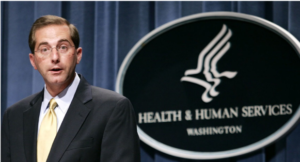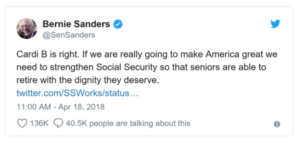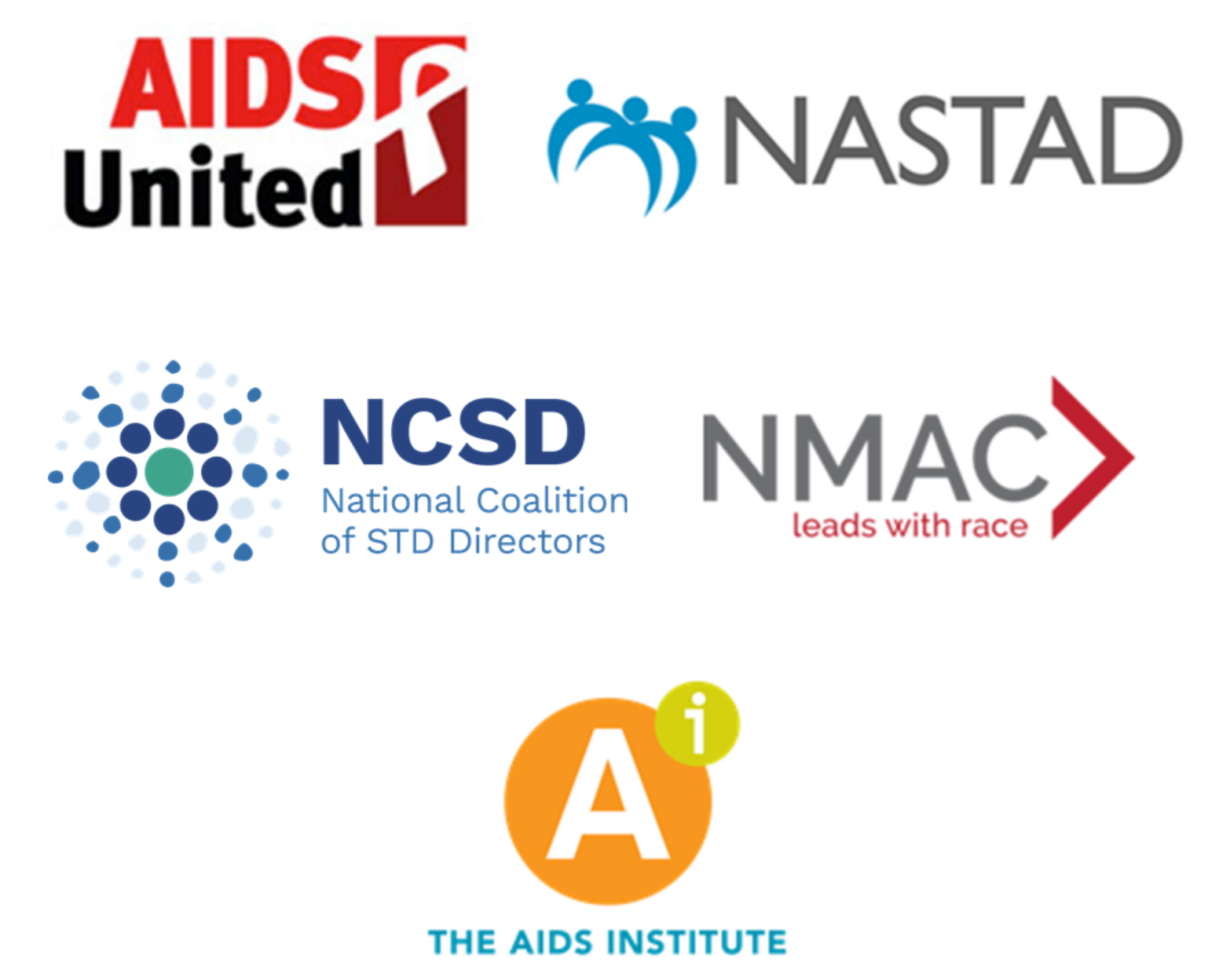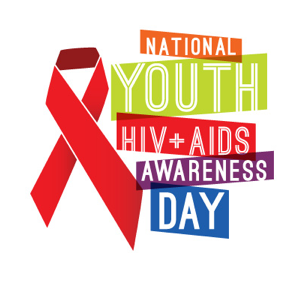Important Happenings in
HIV/Health Policy
Week Ending: April 20, 2018
By: Matthew Rose & Sable K. Nelson
Senate Hearing FY19 HHS Funding Postponed
Health and Human Services (HHS) Secretary Alex Azar was scheduled to testify on HHS’s FY19 budget reques t at a Senate Labor-HHS Appropriations hearing on Thursday, April 26. However, due to Secretary Azar’s recent hospitalization related to continued complications with a digestive infection, the Senate Labor-HHS Appropriations hearing will be postponed. It is still unclear when Azar will return to Washington. For more information,
t at a Senate Labor-HHS Appropriations hearing on Thursday, April 26. However, due to Secretary Azar’s recent hospitalization related to continued complications with a digestive infection, the Senate Labor-HHS Appropriations hearing will be postponed. It is still unclear when Azar will return to Washington. For more information,
READ → https://www.washingtonexaminer.com/policy/healthcare/hhs-secretary-alex-azar-heads-back-to-hospital
HHS Drug Strategy Under Review
On April 17, The Office of Management and Budget began its review of a strategy developed by HHS to lower prescription drug prices and reduce out-of-pocket costs for consumers. On April 26, President Trump plans to announce the steps his Administration will take to fight high drugs costs. According to the Trump Administration’s 2019 Budget Fact Sheet on lowering the price of drugs, pricing policies include changes to Medicare, Medicaid, the 340B drug pricing program that allows safety-net hospitals to get drug discounts, and speeding the development of more affordable generic medications.
For more information,
READ → https://khn.org/morning-breakout/trump-to-give-speech-on-drug-prices-but-no-new-policies-are-expected-to-be-unveiled/
Kaiser Health Network (KHN) ‘What The Health?’ Podcast:
Nothing In Health Care Ever Goes Away
“In this episode of KHN’s ‘What the Health?’ Sarah Jane Tribble of Kaiser Health News, Joanne Kenen of Politico, Margot Sanger-Katz of The New York Times, and Paige Winfield Cunningham of The Washington Post examine how even after Republicans failed to repeal and replace the Affordable Care Act, the health care debate continues to roil politics. They discuss how Republicans in Congress have shifted their ACA messaging and how the Democrats are looking to Medicare expansion. They also discuss state efforts to expand Medicaid and drug pricing. And they spend a moment talking about Congress’ push to do something about the opioid crisis.”
What NMAC is Doing About It
- NMAC remains vigilant in its advocacy to protect FY19 government funding and the existence of the social safety net.
- NMAC will continue to meet with congressional staff about the importance of HIV funding.
- NMAC will continue to discuss how to implement the recommendations from our Biomedical Blueprint.
- NMAC is planning a face-to-face meeting with the CDC Director and a site visit with colleagues with the Federal AIDS Policy Partnership (FAPP) in May 2018.
What You Can Do
FOLLOW CARDI B’S LEAD: In a recent interview with GQ Magazine, Cardi B remarked “I love government. I’m obsessed with presidents. I’m obsessed to know how the system works.” Cardi B went on to say that President Franklin Delano Roosevelt tried to “make America great again for real” by helping old people to receive social security. Even Senator Bernie Sanders (I-VT) cosigned this component of Cardi B’s interview via Twitter:
 Components of the social safety net: the Ryan White Program, Food Assistance, Medicaid, Medicare and Social Security are facing possible program changes and funding cuts in FY19. As various proposals are being discussed, we each have the responsibility to educate ourselves about the issues, systems, and decision-makers that impact our daily lives.
Components of the social safety net: the Ryan White Program, Food Assistance, Medicaid, Medicare and Social Security are facing possible program changes and funding cuts in FY19. As various proposals are being discussed, we each have the responsibility to educate ourselves about the issues, systems, and decision-makers that impact our daily lives.
TAKE ACTION: Speak truth to power by sharing your personal stories with your elected officials. It is vitally important to meet to your federal elected officials when they are home. If we don’t support and advocate for HIV funding and programs, who will? Our movement cannot afford to stand on the sidelines. Your U.S. Senators and U.S. Representatives need to hear from you.
- Find your U.S. Senators: https://www.senate.gov/general/contact_information/senators_cfm.cfm
- Find your U.S. Representative: https://www.house.gov/representatives/find-your-representative
Also, MAKE SURE THAT YOU ARE REGISTERED TO VOTE in time for the primary and general elections happening this year:
|
Nebraska |
4/30/2018 |
| Mississippi | 5/7/2018 |
| Montana | 5/7/2018 |
| New Mexico | 5/8/2018 |
| South Carolina | 5/14/2018 |
| New Jersey | 5/15/2018 |
| Nevada | 5/15/2018 |
| Alabama | 5/21/2018 |
| South Dakota | 5/21/2018 |
| California | 5/21/2018 |
| Virginia | 5/21/2018 |
| Maine | 5/22/2018 |
| Iowa | 5/25/2018 |
| Utah | 5/27/2018 |
| District of Columbia | 5/29/2018 |
For more information, VISIT→ https://www.eac.gov/voters/register-and-vote-in-your-state/
Finally, PARTICIPATE IN THE PRIMARY ELECTION(S) in your state:
| Indiana | 5/8/2018 |
| Ohio | 5/8/2018 |
| North Carolina | 5/8/2018 |
| West Virginia | 5/8/2018 |
| Pennsylvania | 5/15/2018 |
| Idaho | 5/15/2018 |
| Oregon | 5/15/2018 |
| Nebraska | 5/15/2018 |
| Arkansas | 5/22/2018 |
| Georgia | 5/22/2018 |
| Kentucky | 5/22/2018 |
For more information, VISIT→ http://www.ncsl.org/research/elections-and-campaigns/2018-state-primary-election-dates.aspx
 In our fight, Larry Kramer is mythic. As a young queen who was overwhelmed by the loss of so many friends, I found inspiration and courage from Larry’s iconic piece in the
In our fight, Larry Kramer is mythic. As a young queen who was overwhelmed by the loss of so many friends, I found inspiration and courage from Larry’s iconic piece in the  hcare, medications, and wrap-around services has never been greater. Not only is there great benefit to the individuals, but there is also a prevention factor. Ending this epidemic requires leaders from communities living with HIV and people who are sexually active or use needles to work together. We have the science to create real pathways to end HIV. What would Larry say if we wasted this opportunity?
hcare, medications, and wrap-around services has never been greater. Not only is there great benefit to the individuals, but there is also a prevention factor. Ending this epidemic requires leaders from communities living with HIV and people who are sexually active or use needles to work together. We have the science to create real pathways to end HIV. What would Larry say if we wasted this opportunity? Our movement owes a huge debt to all the leaders who spoke truth to power. It may seem unbelievable now, but there truly was a time… I’m going to leave that story for Larry to share. Join us as we sit at the feet of one of our movement’s elders. Space will be limited and NMAC may need to adjust seating arrangements so that everyone will fit.
Our movement owes a huge debt to all the leaders who spoke truth to power. It may seem unbelievable now, but there truly was a time… I’m going to leave that story for Larry to share. Join us as we sit at the feet of one of our movement’s elders. Space will be limited and NMAC may need to adjust seating arrangements so that everyone will fit.

 NMAC gave an olive branch to the new Director when we invited him to the
NMAC gave an olive branch to the new Director when we invited him to the  We can’t do this alone. It’s going to take a movement to make this work. This is the first bridge we’ve had to an administration that has many of us concerned. Deciding to cross the bridge is a test of our leadership. For some it will be impossible. For others it will be impossible not to. There is no clear right answer, but NMAC has always been committed to working with the federal government regardless of the administration. This is also our test.
We can’t do this alone. It’s going to take a movement to make this work. This is the first bridge we’ve had to an administration that has many of us concerned. Deciding to cross the bridge is a test of our leadership. For some it will be impossible. For others it will be impossible not to. There is no clear right answer, but NMAC has always been committed to working with the federal government regardless of the administration. This is also our test.




